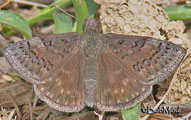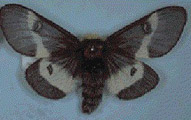Native Plants
Search for native plants by scientific name, common name or family. If you are not sure what you are looking for, try the Combination Search or our Recommended Species lists.
Quercus ilicifolia
Quercus ilicifolia Wangenh.
Bear Oak, Scrub Oak
Fagaceae (Beech Family)
Synonym(s):
USDA Symbol: QUIL
USDA Native Status: L48 (N), CAN (N)
A small tree or shrub, 12-20 ft. tall with a short, contorted trunk; slender, horizontal branches; and bristle-lobed leaves turning reddish-purple in fall. Catkin appears just before or with the appearance of new leaves. BARK: dark gray, thin mature bark becoming scaly. TWIGS and BUDS: pubescent yellowish-brown to brown twigs when young, dark brown and smooth when older; terminal buds ovoid and 1⁄8 inch (3 mm) long. LEAVES: smooth petiole up to 2 3⁄8 inches (60 mm) in length; leaves are ovate to elliptical, 2 - 4 3⁄4 inches - 38 - (51 - 121 mm) long, 1 1⁄8 - 3 1⁄2 inches (29 - 89 mm) wide, base cuneate (wedge shaped), 3 - 7 lobes separated by shallow sinuses and ending in 1 - 3 bristle-tipped teeth, apex usually has 3-tipped lobe, thick and leathery, upper surface shiny dark green, lower surface pale green to gray with dense woolly pubescence, secondary veins raised on both surfaces.
A temporary scrub type after heavy cutting and repeated fires, Bear Oak is replaced by taller pines and oaks. The Latin species name, meaning "holly leaf," refers to the foliage. It is called "Bear Oak," reportedly because only bears like the very bitter acorns. Bear oak is a transition species that depends upon stand disturbance. Fire promotes this species.
From the Image Gallery
No images of this plant
Plant Characteristics
Duration: PerennialHabit: Shrub , Tree
Leaf Retention: Deciduous
Leaf Arrangement: Alternate
Leaf Complexity: Simple
Leaf Shape: Elliptic , Ovate
Leaf Venation: Pinnate
Leaf Margin: Lobed
Leaf Base: Cuneate
Leaf Texture: Leathery
Breeding System: Flowers Unisexual , Monoecious
Inflorescence: Catkin
Fruit Type: Nut
Size Notes: Normally grows to a height of 18 feet (5.5 m) and occasionally to 41 feet (12.5 m).
Leaf: Upper surface shiny dark green, lower surface pale green to gray with dense woolly pubescence.
Autumn Foliage: yes
Fruit: Acorns biennial; cup is reddish-brown with pubescent scales, inner surface pubescent, covers up to 1⁄2 of the nut; ovoid, light brown nut with faint stripes and minute pubescence, up to 5⁄8 inch (16 mm) long.
Bloom Information
Bloom Color: Red , Yellow , GreenBloom Time: Mar , Apr , May , Jun
Distribution
USA: CT , DE , MA , MD , ME , NC , NH , NJ , NY , PA , RI , VA , VT , WVCanada: ON
Native Distribution: S. ME w. to NY, s. to PA, MD & in the mts. to e. WV, s.w. VA, & w. NC.
Native Habitat: Disturbed areas; barrens; rocky ridges. Often found in pure stands associated with dry sandy, barren, and rocky hillsides, or mountainous terrain.
Growing Conditions
Light Requirement: SunSoil Moisture: Dry
Soil Description: Acidic, sandy or gravelly soils.
Conditions Comments: Can suffer chlorosis due to absence of soil nutrients. Long-lived. A
Benefit
Use Wildlife: Acorns provide food for wildlife, especially turkey and grouse.Use Medicinal: The Iroquois peoples used bear oak for treating gynecological problems.
Attracts: Birds
Butterflies and Moths of North America (BAMONA)
|
Sleepy Duskywing (Erynnis brizo)  Larval Host |
Eastern buckmoth (Hemileuca maia)  Larval Host |
Find Seed or Plants
View propagation protocol from Native Plants Network.
Bibliography
Bibref 1186 - Field Guide to Moths of Eastern North America (2005) Covell, C.V., Jr.Bibref 1134 - Field Guide to Native Oak Species of Eastern North America (2003) Stein, John D. and Denise Binion
Bibref 1185 - Field Guide to Western Butterflies (Peterson Field Guides) (1999) Opler, P.A. and A.B. Wright
Search More Titles in Bibliography
Additional resources
USDA: Find Quercus ilicifolia in USDA PlantsFNA: Find Quercus ilicifolia in the Flora of North America (if available)
Google: Search Google for Quercus ilicifolia
Metadata
Record Modified: 2011-09-26Research By: TWC Staff